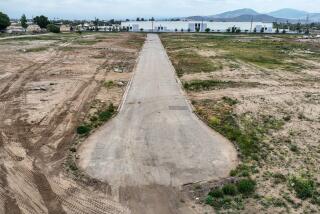Developers’ Park Fees Far Below Land Values
- Share via
Throughout the 1980s, developers in Orange County often preferred to comply with a county park law by paying fees instead of giving away land.
And who could blame them. They were saving hundreds of thousands of dollars.
For most of the decade, officials concede, the park-related fees charged by county government were based on outdated and below-market land values.
From 1978 to 1985, the park fees were based on the assumption that land was worth $28,000 an acre, county documents show. It was not until July 1, 1985, that county supervisors ordered that the park fees be phased upward, based on land values more closely resembling actual market levels.
Yet as land prices continued booming toward $1 million an acre in many parts of South Orange County, developers until mid-1988 were allowed to pay fees based on values that were a mere $172,500 an acre and lower.
The gaping disparity between the county’s low fees and the actual cost of buying Orange County real estate for parkland was highlighted as far back as April 24, 1981, in an internal county memo.
“The county’s existing local park fee structure generates insufficient revenues to acquire and develop local park sites at today’s costs,” said the memo, from Environmental Management Agency executive R.F. Wingard.
Another warning was sounded in a March 8, 1982, staff memo to the Board of Supervisors: “Because fees do not represent market value, the revenue generated is insufficient to provide local parks.”
But it was not until July 1, 1985, that the supervisors took the first step toward overhauling the park fee structure.
“Frankly, we had difficulty getting this point recognized and dealt with fairly and squarely both in the county family and in the development industry,” said Eric Jessen, the county Environmental Management Agency’s chief of parkland acquisition.
The valuations--and the reduced revenues they generated--are part of the reason why Orange County has significant shortages of neighborhood parks.
That’s because the fees are used by the county to buy acreage and to convert existing, undeveloped public lands into playgrounds or other recreational uses. If the fees don’t keep pace with the actual cost of land, significant acquisitions and improvements become impossible.
Park fees are most typically paid in developments of 50 dwelling units or less. But county officials also may allow developers of larger-scale communities to satisfy their park obligation through a combination of fees and land. The Orange County local-park law’s basic standard is 2.5 acres of land for every 1,000 new residents to be generated by a development.
And the development industry likes the fees low. Representatives of the Building Industry Assn. have consistently opposed upgrades that exceed the overall rate of inflation, as measured by the Consumer Price Index.
The significance of setting park fees based on up-to-date land values was explained by William Price, chief of appraisals for the county’s real estate unit:
“The idea is to put parks into areas that are being developed,” Price said in an interview. “And in order to do that, you have to pay the value of the land.”
Yet until July, 1988, the county’s fees were either not updated annually or done so based on conservative, yearly increases in the CPI.
Although CPI measures overall price changes of a spectrum of consumer goods and services--such as food, entertainment, clothing and housing--experts do not consider it the most accurate gauge of land values.
Consequently, during the booming development period from July 1, 1987, through June 30, 1988, Orange County increased its parkland fees by just 2.1%. In the then-booming areas of Mission Viejo and Laguna Niguel, that meant a per-acre-value rise to $176,500 an acre, up from $172,900.
But the increase was “not at all” in keeping with land prices during the period, according to Byron R. Hoffman, owner of the Hoffman Co. land brokerage in Irvine. Orange County land values at that point, Hoffman said, “were going up very noticeably, in some cases dramatically.”
It wasn’t until the end of the decade that county supervisors began bumping the park fees up significantly. Acting just weeks after they had already approved the last of 18 major development agreements in areas of the South County, the supervisors on July 1, 1988, increased the land value base for park fees by 42%, from $176,500 an acre to $250,000 an acre.
One year later, on July 1, 1989, the supervisors raised the figure for most of Laguna Niguel to $750,000 an acre--a 200% leap. But by then, most of the housing developments that can fit in the city were either completed or well under way.
More to Read
Sign up for Essential California
The most important California stories and recommendations in your inbox every morning.
You may occasionally receive promotional content from the Los Angeles Times.














